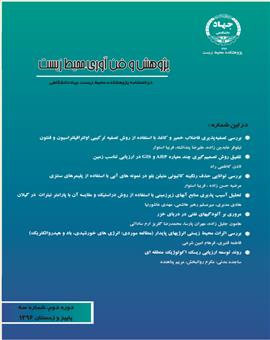بررسی اثرات محیط زیستی انرژیهای پایدار (مطالعه موردی: انرژيهاي خورشیدی، باد و هیدروالکتریک)
محورهای موضوعی : Environment and energyفاطمه قنبری 1 , فرهام امین شرعی 2
1 - عضو هیات علمی
2 - عضو هیات علمی دانشگاه ازاد نجف آباد
کلید واژه: اثرات محیطزیستی انرژی تجدیدپذیر انرژی خورشیدی انرژی باد انرژی هیدروالکتریکی,
چکیده مقاله :
افزایش آلودگی هوا و ایجاد گرمایش جهانی در اثر استفاده بیرویه سوختهای فسیلی توجه عموم را به سمت تغييرات آب و هوايي معطوف كردند. بر همين اساس انتظار افزايش تقاضا براي ساير انرژي هاي جايگزين بخصوص انرژي هاي تجديد پذير قابل پيشبيني است. در حالیکه برخی از تحقیقات بر روی انرژیهای تجدیدپذیر نشان میدهد که این نوع از انرژیها نیز دارای اثرات نامطلوب محیطزیستی هستند. در این مطالعه به بررسی سیستمهای انرژی خورشیدی، انرژی باد و هیدروالکتریک پرداخته و اثرات آنها از نظر آلودگی هوا، خاک، صوت و اثر بر روی حیات وحش بررسی شده است. نتایج نشان میدهد علیرغم اینکه این نوع از انرژیها به عنوان انرژی پاک خوانده میشوند دارای اثرات محیطزیستی منفی می باشند. اين تحقیق همچنين مواردی كه موجب جلوگیری از بروز اثرات مخرب منابع انرژي تجديدپذير را پیشنهاد میدهد.
Increasing air pollution and global warming due to the excessive use of fossil fuels attracted public attention to climate change. Accordingly, the expected increase in demand for other alternative energy sources especialy renewable energy is predictable. While some research on renewable energy shows that these kind of energy also have undesirable environmental effects. In this study solar energy systems, wind power and hydroelectric power systems wew investigated and their effects on air, soil, sound and effect on wildlife were studied. The results show that although these kind of energy are called clean energy, they have negative environmental effects. This research also suggests ways to prevent the effects of destructive renewable energy sources.
[1] Abbasi, S.A., 1987. Renewable energy from aquatic biomass, Proceedings of the International Congress on Renewable Energy Source, S. Terol (Ed.), CSIS, Madrid, pp. 60-69.
[2] Danyel Reiche, editor. 2003. Handbook of renewable energies in the European Union, vol. II. Frankfurt, Germany.
[3] Meir, I and S. Roaf., 2003. Back to the future. Open university, UK.
[4] Krishna, A., 2001. Climate Responsive Architecture: A Design Handbook for energy Efficient Buildings, McGraw-hill, New York.
[5] Osamu I., Takashi O., Izumi K., Hiroshi M.., 2005. current status and future prospect of PV development in Japan: beyond 1GW of PV installed capacity. In: Proceedings of the 20th European photovoltaic solar energy conference and exhibition, Barcelona.
[6] Etheridge D.W., 2000. Unsteady flow effects due to fluctuating wind pressures in natural ventilation design- instantaneous flow rate, Building and Environment 35 (4) 321-337.
[7] Abbasi, S.A., 1991. Environmental impact of water resources projects, Discovery Publishing House, New Dehli.
[8]Abbasi, S.A. and Bhatia, K.K.S., 1991. Environmental impact assessment of upper Krishna project, Proceedings of Fourth National Symposium on Hydrology, pp. 223-227.
[9] Huld T, Dunlop E. PV electricity potential in EU25 Member States. In: Ja ger Waldau A, editor. Status report 2007. energy end-use efficiency and electricity from biomass, wind and photovoltaics in European Union. Luxembourg: office for Oficial Publications of the European Communities; DG JRC Report.
[10] Energy for the future: renewable sources of energy. 1997. White paper for community strategy and action palan, COM (97)599 final draft.


